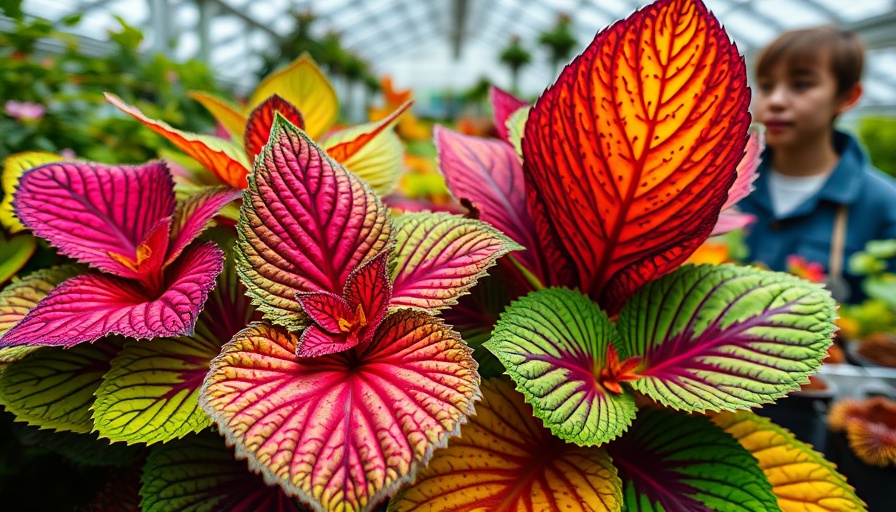
The Rise of Uncommon Garden Plants: Discovering Perilla and Coleus
As more homeowners with gardens look to elevate their green spaces, it's essential to distinguish between the myriad of plants available. Among these, Perilla and Coleus plants are gaining attention for their unique qualities. Both species contribute not only beauty but also a variety of uses in culinary and medicinal realms. This article delves into the notable differences and similarities between these fascinating plants, aiding you in your gardening journey.
The video 'The Difference Between Perilla and Coleus Plants' presents an engaging discussion around these unique plant species, prompting us to explore their characteristics and gardening benefits further.
Understanding the Basics: What are Perilla and Coleus?
To appreciate the uniqueness of Perilla and Coleus plants, let's first explore what defines them. Perilla, also known as Shiso in Japanese cuisine, is characterized by its striking, serrated leaves and aromatic qualities. Its flavor profile presents a delightful blend of minty and herbal notes that can elevate many dishes, particularly in Asian cooking.
Coleus, on the other hand, is cherished primarily for its vibrant foliage. With a range of colors—from deep purples to bright greens—Coleus plants are often used as ornamental accents in gardens. Unlike Perilla, Coleus does not have a significant culinary use, making it a purely decorative choice.
Distinct Features and Care
While both plants are relatively easy to care for, they thrive under different conditions. Perilla prefers full sun and well-drained soil, making it suitable for sunny garden spots. Alternatively, Coleus can adapt to partial shade, allowing homeowners to utilize its vivid colors even in less sunny areas.
In terms of watering needs, Perilla requires consistent moisture to maintain its lush foliage, while Coleus is more forgiving and can withstand occasional dryness. Knowing these care specifics allows gardeners to create harmonious landscapes while ensuring their plants flourish.
Culinary Versatility: A Taste Comparison
Perilla's culinary versatility sets it apart from Coleus. Used in dishes like sushi, salads, and even as a garnish, this plant opens a world of flavor. Seasoned gardeners often recommend incorporating Perilla into marinades and dressings, as its unique flavor complements proteins and enhances fresh vegetables.
In contrast, while Coleus thrives in decor, it does not play a role in culinary applications. However, both plants can be beneficial in a garden setting: Perilla enriches meals, while Coleus serves as a visual delight, inspiring creativity in landscape design.
Environmental Impact and Sustainability
The growing trend of incorporating both Perilla and Coleus into home gardens aligns well with sustainability principles. Perilla, for instance, requires less water than some traditional herbs, making it an eco-friendly choice. This aligns with a broader movement towards selecting plants that conserve water and reduce the carbon footprint of gardening.
Coleus helps enrich the ecosystem as well, attracting pollinators like bees and butterflies. This biodiversity contributes to a healthy garden, supporting local ecosystems and amplifying the beauty and productivity of your outdoor space.
Future Trends: Embracing Diversity in Gardening
As gardeners increasingly seek to enrich their landscapes, it is vital to embrace diversity. The incorporation of unconventional plants such as Perilla and Coleus not only enhances the visual appeal but also encourages sustainability. Future gardening trends will likely focus on plant varieties that support local ecosystems while providing aesthetic and culinary benefits.
In this context, homeowners are encouraged to explore these unique options, contributing to a healthier planet, and creating gardens that reflect personal style and environmental consciousness.
Conclusion: The Perfect Pair
In exploring the differences between Perilla and Coleus plants, we find that each has its unique charm that can appeal to different gardeners. Whether you want to spice up your culinary repertoire with Perilla or add a splash of color to your landscape with Coleus, both plants provide incredible benefits to any garden.
As you consider expanding your garden, think about incorporating these vibrant plants. Engaging with nature through gardening not only beautifies your home but fosters a connection to the environment that is both rewarding and vital for future sustainability efforts.
By taking action and planning your garden wisely, you can cultivate not only plants but a thriving ecosystem that enhances your living space and encourages harmony with nature.
 Add Row
Add Row  Add
Add 




Write A Comment